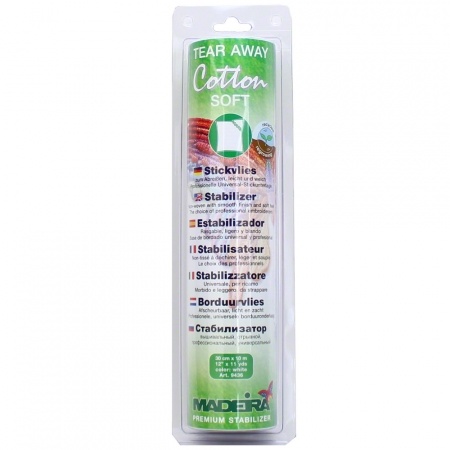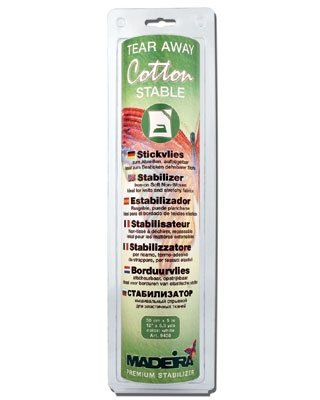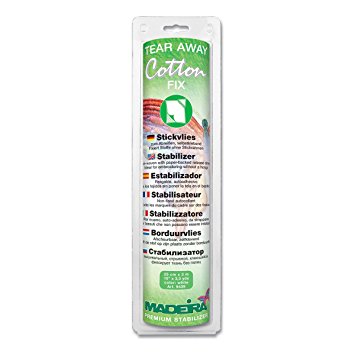
When it comes to machine embroidery, stabilizers are a crucial aspect to consider. Finding a top-notch stabilizer is essential to make the embroidery process more comfortable and efficient.
Questions: Could you please explain the primary function of stabilizers and how they can be utilized? Additionally, could you provide some details on tearaway stabilizers and how they can be described?
We will provide answers to all of these questions promptly. Selecting the appropriate stabilizer type is not a complex task. It is essential to understand their functions to use the suitable one for each circumstance.
Stabilizers are not your typical non-woven fabric. They possess unique qualities that impact the tissue's extensibility differently.
In the world of stabilizer production, it can be overwhelming to navigate through the numerous firms available. However, as we gather more information, we understand that there are only a few types of stabilizers, and the information falls into place more easily.
There is a division between upper and lower.
When embroidering on loose fabrics like knitwear, velvet, or velour, it's important to use an upper stabilizer to prevent the stitches from disappearing. This will ensure that your embroidery doesn't fail. Lower stabilizers can be used to either stabilize the fabric or replace it entirely, especially when embroidering on laces.
According to their technical characteristics, the stabilizers are divided into: tear away, cut away, wash away and fusible.
There are various types of stabilizers used for different fabrics and situations. Tear-away stabilizers for machine embroidery have a unique role in fixing the fabric. Manufacturers offer a range of densities, with some even providing up to four different kinds. These stabilizers also prevent the fabric from puckering.
Tear away are used like lower temporary stabilizers. After embroidery, they are removed from the embroidered outline. Depending on the density they are used with different types of fabrics.
They can be either glue or non-glue. If the stabilizer has a glue base, then it won`t be difficult for you to glue the fabric to it with an iron. If the stabilizer does not have glue base, you will need use a special fabric glue stick. This type of stabilizer can cooperate well with most natural fabrics.
General recommendations for using
This technique is effective for products that display the incorrect side of embroidery, such as towels, blankets, and scarves. It is also commonly used for light, opaque fabrics and dense, sturdy natural fabrics like denim. However, it is not advisable to use it with knitted materials.
Tear-off stabilizers, as a rule, are a paper and can have different thicknesses.
There are a lot of tear away stabilizers producers, which offer to their clients a range of different types. The most popular are Fixier-Stickvlies, Guterman, and Madeira.
Ultra Stable is a particularly durable, adhesive, nonwoven stabilizer, designed to stabilize fabrics when you embroider with a many of stitches and small parts. It is fastened to the fabric by smoothing with a hot iron and can hold for a long time. It is perfect for dense machine embroidery and textile decorations.
Fixier-Stickvlies is used to stabilize machine embroidery, especially on elastic fabrics. It makes possible to accurate embroidery on elastic fabrics and is easily removed after finishing.
For testing our designs we use Madeira`s production stabilizer. They are high quality and perfectly handle with the stabilization of embroidery process.
- Avalon Cotton Soft
- Avalon Cotton Stable
- Avalon Cotton Fix
Avalon Cotton Soft Stabilizer in white and black is an all-purpose stabilizer compatible with sewing and embroidery machines. It effectively stabilizes the fabric, preventing any puckering during embroidery. This stabilizer is ideal for machine embroidery and appliqué and for producing decorative buttonholes and patchwork. The soft non-woven fabric is made from cotton without any synthetic additives. Its smooth and gentle texture is perfect for sensitive skin and even children's clothing.
Using instructions
Take the needed amount of stabilizer and place it under the fabric on which the embroidery will be made (picture 1). Fill in the hoop, the fabric with a stabilizer (picture 2). After embroidering (picture 3), remove the excess edges of the stabilizer (picture 4).
Stabilizer Avalon Cotton Stable in appearance and touch is similar to Cotton Soft, but has on one side an adhesive covering, thanks to which it is glued with the iron to the fabric. Cotton Stable is easily removed. Also, it is perfect for stabilizing embroidery on high-elastic fabrics, for example, t-shirts, jersey, knitted fabric. It is used in the manufacture of buttonholes on elastic fabrics, for applications, embroider computer designs.
Using instructions
Take the needed amount of stabilizer. Place the adhesive side on the underside of the fabric. Press it (picture 1). Mind that the temperature of the iron depends on the type of fabric. After 10-15 seconds, the stabilizer will begin to stick. Fit in the hoop the fabric from the top (picture 2). At the end of the work (picture 3) you should remove the Cotton Stable (picture 4).
Buttonholes: Cotton Stable is indispensable when you are making buttonholes on elastic fabrics. Press as described above, Cotton Stable to the wrong side of the fabric, make the embroidery, remove excess stabilizer.
Stabilizer Cotton Fix is similar to Cotton Soft, but has on one side an adhesive coating protected by a paper base. Used for machine embroidery, as it fixes fabric without hoop. This is relevant for materials on which traces of the hoop remain (velvet, suede). Cotton Fix is also successfully used for patchwork: small parts are fastened to the desired pattern. The stabilizer is ideal for velvet, leather, collars, cuffs, knitted fabrics, jersey, high-elastic fabrics, t-shirts, appliqués, patchwork.
Using instructions
Take the needed amount of stabilizer. Fill the stabilizer in the hoop with the paper base up. Then make a cross-cut with scissors (picture 1). Caution: Make the cut on the paper base, without damaging the blade. Tear off the top paper (picture 2). Put a fabric on the adhesive surface and press (picture 3). After embroidering, carefully separate the embroidery from the fabric as it easily detaches (picture 4).
You have to attentively approach to the choice of a suitable stabilizer. Remember that the wrong stabilizer can damage you embroidering and lead to appearance of some defects.
You may also like
Getting to know Madeira Avalon stabilizers

Author: Ludmila Konovalova
My name is Lyudmila Konovalova, and I lead Royal Present Embroidery. Embroidery for me is more than a profession; it is a legacy of my Ukrainian and Bulgarian heritage, where every woman in my family was a virtuoso in cross-stitch and smooth stitching. This art, passed down through generations, is part of my soul and a symbol of national pride.
Date: 24.11.2017









 Get Sign-In Link
Get Sign-In Link Login with Google
Login with Google Login with Facebook
Login with Facebook Login with Amazon
Login with Amazon Login with Paypal
Login with Paypal